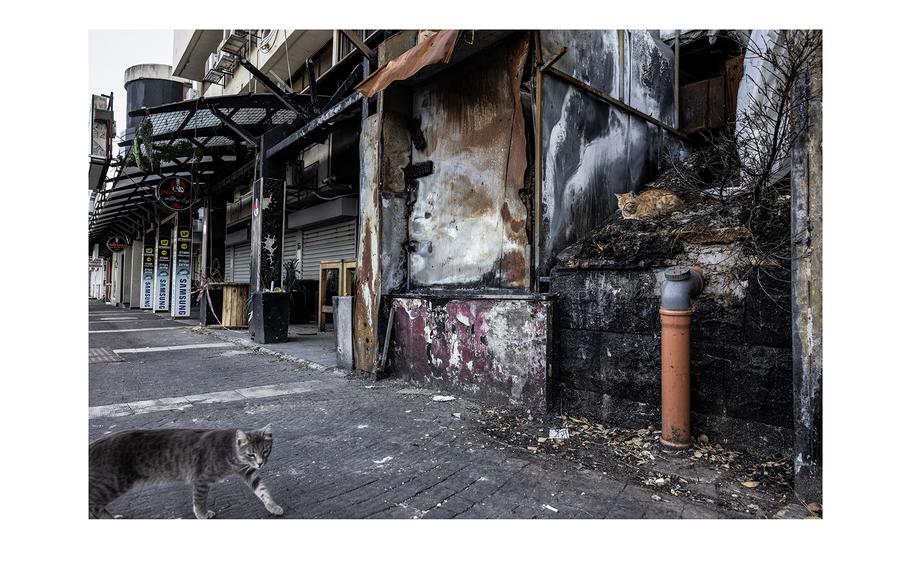
Stray cats roam the deserted streets of the northern Israeli city of Kiryat Shmona, where rockets fired by Hezbollah, an Iranian-backed militant group, damaged a restaurant several months ago. (Heidi Levine for The Washington Post)
ALONG ISRAEL’S BORDERS WITH GAZA AND LEBANON — Six months after Oct. 7, Israelis are struggling to recover their bearings, their core, their belief that Jews are safe in Israel.
In Israel’s south and north, more than 120,000 people have been evacuated, their neighborhoods transformed into front lines. The homes sit empty, toys still scattered in front yards.
In the southern kibbutzim, where 3,000 Hamas-led fighters launched a surprise assault on that indelible Saturday morning, the residents return not to live but to serve as guides for visitors from abroad. They give heart-rending tours, recounting how 1,200 people were slaughtered and 253 hostages were dragged into Gaza, according to Israeli government figures.
Evacuees fear that their communities are becoming places frozen in time and loss. They worry that if no solution is found for them — if security is not restored along the borders they share with their enemies — the rest of the country will remain exposed, in a permanent state of existential danger.
There is nationwide support for the military’s punishing war against Hamas, which has killed 32,000 Palestinians, according to the Gaza Health Ministry. The ministry does not distinguish between civilians and combatants but says most of the dead are women and children.
The images from Gaza — of shattered cities, families killed together in their homes, malnourished children — do not often appear on the nightly news here. Most of the world thinks Israel has gone too far. Most Israelis don’t think they’ve gone far enough.
In the ghost towns of the north, residents are haunted by uncertainty. A retired intelligence officer, Sarit Zehavi, said she sleeps fitfully five miles from the border, “listening for voices outside,” for “the monster” at the door.
The northern front faces daily rocket and missile fire from Hezbollah, the Lebanese militant group and political party that is backed by Iran.
The people of both borderlands feel that outsiders, even their fellow Israelis, cannot fully understand their sense of vulnerability.
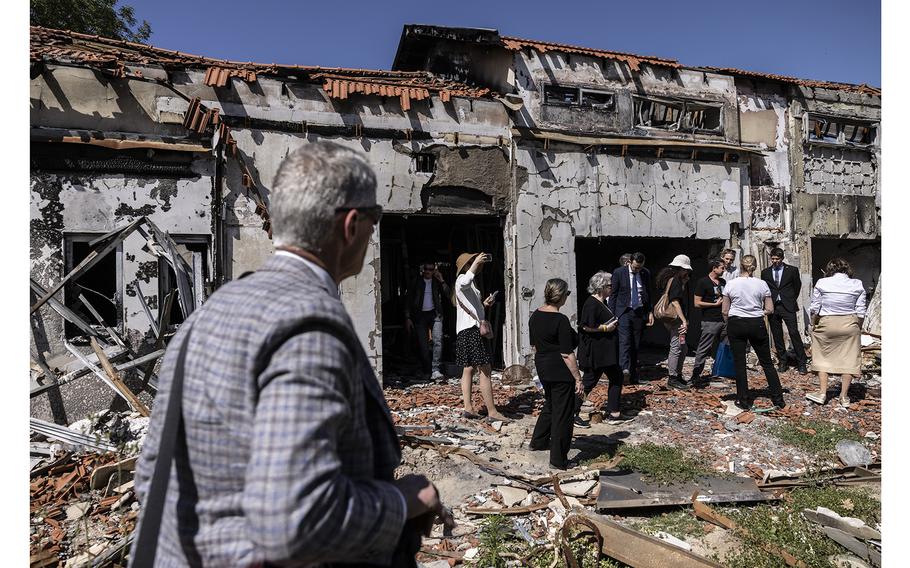
A delegation of police from Austria tours Kibbutz Beeri last week. (Heidi Levine for The Washington Post)
A recent poll by the Israel Democracy Institute found that more than 60 percent of Israelis say their lives have returned to normal; they have returned to work, are getting together with family and friends, planning for the upcoming Passover holiday.
But they have changed. Asked how they feel, that is what they say: changed.
Many flock to the beach in Tel Aviv, but it is just a mile from the newly formed “Hostage Square,” where families and thousands of their supporters have gathered, strategized, and held weekly Saturday night rallies to bring their loved ones home.
Many Israelis have pivoted to the right, believing the prospect of a Palestinian state threatens the future of their nation. More than 230,000 Israelis have taken out gun licenses, in a constant state of high alert.
Volunteers have been flowing into Israel’s new front lines, in the north and the south, helping to tend agricultural fields and guard the perimeters. Middle-age men with dad bods have joined home defense units, patrolling in golf carts, militarizing what were once suburban neighborhoods.
Mothers, like Zehavi, have escape routes planned. “We have told children, if you hear sirens, go to the safe room inside. If you hear guns shots, leave the house and run.”
In Kibbutz Beeri, one of the pastoral villages that hug Israel’s border fence with the Gaza Strip, Alon Pauker says that he recently returned to his full-time job as a professor at Beit Berl College, in the center of the country. But he has also, for the past six months, been devoted to his second, unofficial job in Israeli diplomacy — memorializing his 96 neighbors who were murdered on Oct. 7, and the 26 more who were taken hostage, for an audience of international diplomats, humanitarian workers and donors who he believes will be instrumental in allowing Israel to finish its mission in Gaza.
“I have gone from being a historian to a Holocaust tour guide — a one-day Holocaust,” he said on a recent afternoon after concluding a two-hour round through the ruins with international aid workers.
Pauker walked them through Beeri’s hardest hit neighborhoods, showing the houses with their roofs torn off during heavy fighting, children’s shoes charred beyond recognition, bullet holes and grenade blasts covering virtually all surface areas. Even some of the air conditioning units were torched, a tactic used by Hamas fighters to smoke victims out of their homes.
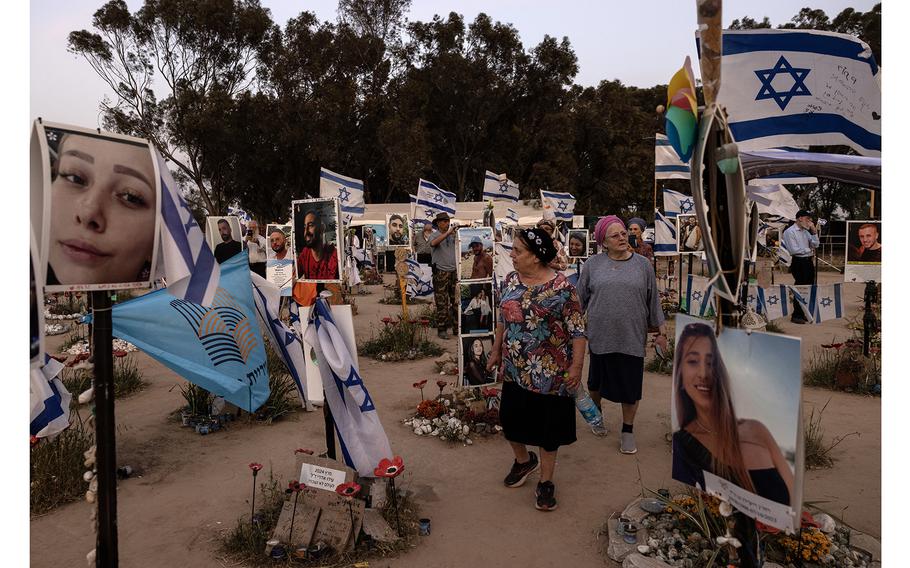
Visitors to the memorial site of the Tribe of Nova trance music festival, where on Oct. 7, Hamas militants killed 360 people and dragged another 40 into Gaza, according to Israeli authorities. (Heidi Levine for The Washington Post)
Pauker’s guests on that day were from the Swiss Red Cross. He wanted them to see and hear, firsthand, what sparked the war.
He understands that the world has been shocked by the widespread death and destruction in Gaza. It pains him, too, he said, but he hopes his tours will help critics understand the cruelty and manipulations of Hamas.
Like so many of his fellow Israelis, he believes the international community should be pressuring Hamas, not Israel, to stop the war.
“The world is angry at the state of Israel, and I, too, am angry at my government for not doing better, for not working to create a horizon for the day after the war,” Pauker told them as he passed photos of those murdered and taken hostage, in some cases both.
“But Hamas is the only factor in Gaza that wants uninvolved civilians to be harmed,” he said. “It wants the world to pressure Israel to stop the war, so they can return to govern in Gaza, and this cannot happen.”
Six months into the war, Israel is in a state of muddled suspense. The security establishment says it has dismantled most of Hamas’s battalions, but tens of thousand of fighters — and most of the group’s key leaders — are still believed to be hiding out in tunnels, or holed up in destroyed buildings. While Prime Minister Benjamin Netanyahu still vows to destroy Hamas, Israeli military officials expect that it will remain a lethal guerrilla force.
Residents from the 22 southern Israeli communities attacked on Oct. 7 say that a radical change is needed for them to permanently return home. If security is not guaranteed, many warn, the front-line communities will whither, and the rest of the country — 260 miles in length and 70 miles at its widest point, roughly the size of New Jersey — will be in the crosshairs.
The original purpose of the kibbutz, the collective farm, to lay claim to Israel’s defensible borders, “is truer now more than ever,” said Oshrat Kapitanov, a resident of Beeri and an employee at its historic printing press.
The factory resumed work a week after the attack, not yet knowing it had lost 12 of its workers. For Kapitanov, the return to the kibbutz, to the homes where her friends and family were killed, and to the pressure of a work routine, has been a lifeline.
She is still living in a hotel room with her teenage kids. But her daily pilgrimages to Beeri have allowed her to internalize the loss that, in the first chaotic weeks after the assault, as she rushed from funeral to funeral, she could not process.
“I will come back, my kids will come back, but the question is how,” Kapitanov said. “And we are still waiting for the hostages. Without them, I don’t think rehabilitation will ever be possible.”
With more than 100 Israelis still in captivity in Gaza, the country has been wrestling with how to memorialize the bloodiest day in its 75-year history. Several organizations have begun collecting testimonies on issues like sexual assault. But the survivors say they are still busy surviving.
For many, it all feels too fresh, too raw, too much a part of the present to be treated as history.
In the open field where the Hamas fighters overran a music festival, killing 360 people and dragging another 40 into Gaza, according to Israeli authorities, 23-year-old survivor Ilay Karavani tells a group of visitors from the United States about how he hid in the bushes for hours.
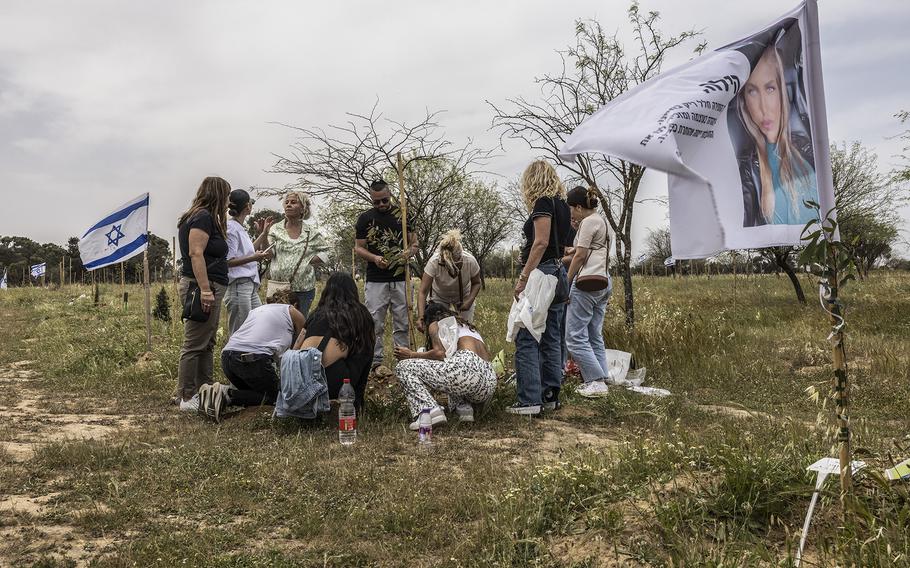
Members of the Naftali family visit the memorial to Eden Naftali, a festivalgoer murdered on Oct. 7, 2023. (Heidi Levine for The Washington Post)
“I’m telling the story, authentically, knowing that it is not what they are getting from Instagram or from American media,” said Karavani. “But for me, coming here helps me deal with this reality” — of his friends who are dead or still inside Gaza.
“We haven’t had time” to recuperate, said Dvir Rosenfeld, from nearby Kibbutz Kfar Aza. He spoke as he unloaded boxes from his truck, lugging belongings from his home to a new hotel apartment, his family’s fourth move in five months.
He shrugged silently, bereft of answers, when asked about the logistics of some day moving back to the kibbutz.
He was also unable to answer questions about how he discusses Oct. 7 with his children, and nephews and nieces, all of whom bear invisible scars. For 20 hours that day, Rosenfeld used the weight of his body to keep the door to his safe room shut as his wife kept her hand over their baby’s mouth.
A few doors down, Hamas gunmen mowed down his sister and her husband, leaving their 10-month-old twins in their cribs. For more than 12 hours, the twins’ cries were used as bait by militants to ambush incoming Israeli rescue teams.
At first, Rosenfeld said, the twins stared at pictures of their parents.
But six months later, along with their cousins, they are learning to walk and talk and live in a country that Rosenfeld no longer recognizes. “We don’t trust anyone anymore,” he said.
Hanan Dann, his neighbor in Kfar Aza, said that while a handful of people have trickled back to the kibbutzim in the south, the return of young families will be critical to their long-term viability.
The parents, he said, speak a lot about the future. They appoint members to receive the tour buses streaming in. They are toying with the idea of building some kind of memorial in the decimated neighborhoods, and rebuilding them elsewhere. Government housing for the kibbutz, under construction now, could be ready by the summer, maybe the fall.
Their kids navigate their trauma from Oct. 7 by being with each other, playing hide-and-seek and making fortresses. They say that their friends were hiding, too, “but we couldn’t find them,” referring to the dozens of children who were kidnapped, or killed.
“But they don’t really understand,” Dann said.
Dann and Rosenfeld have recounted their stories countless times to visitors. They are weary. But they feel compelled to bear witness, again and again, as Hamas and its supporters continue to downplay the group’s atrocities.
“It’s like being in a zoo,” Rosenfeld said. “But it’s worse if there are people, outside, who say that this never happened.”
In the north, residents say they are still waiting for the worst to happen.
What they fear is not just sporadic rocket fire, but a full-scale invasion by a seasoned, well-trained army that is far more powerful than Hamas.
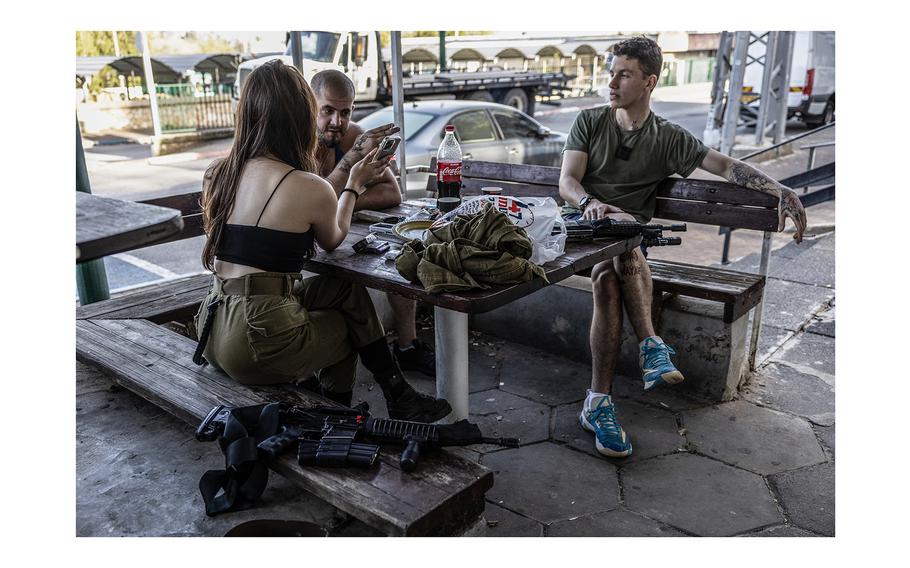
Israeli reservists outside a closed cafe in Kiryat Shmona. (Heidi Levine for The Washington Post)
A young entrepreneur with a rifle slung on his shoulder takes a reporter up to the balcony of an abandoned red-tiled villa in Kfar Giladi overlooking groves of nectarines, alongside the border wall with Lebanon. “I used to tell my wife we are living in Tuscany, but she and the kids won’t come back. None of us will,” Nisan Zeevi said.
“We sense, very clearly, it isn’t safe anymore.”
Thirty-five miles to the southwest lies the Israeli hamlet of Shtula and its only remaining family — Ora Hatan, 60, and her two sons. Hatan spends her days dedicated to feeding hungry, homesick soldiers, when she is not studying for her law school exams or tending to her goats.
Shtula was founded in 1967 to strengthen the Jewish presence in the Galilee. Many members come from the Iraqi diaspora.
“They say I am crazy staying here. I say to my neighbors, ‘You are crazy for leaving!’ This is my home, this is my country, this is my promised land,” Hatan said.
She spends her nights with the blinds drawn, suspecting that Hezbollah fighters can see her cooking through the windows. Several homes in the village have suffered from direct hits. Driving around, you can see the yards overtaken by weeds, the broken windows, everything forlorn.
It is not hard to imagine the village dying.
“This is what they want,” Hatan said, referring to Hezbollah. “They want to put us to sleep.”
Her biggest fear? “That we will never come back.”
Giora Salz is the mayor of the Upper Galilee municipality. His little office in Kiryat Shmona sits next to a situation room that seems designed, readied, to protect a town under imminent attack.
The rest of Israel might be dealing with post-traumatic stress, Salz said, but “here, it is pre-trauma. Here it is before the big event.”
If the families do not return, if the schools do not reopen, his town will disappear, he said, and “the Zionist idea is gone.”
Judith Sudilovsky in northern Israel contributed to this report.